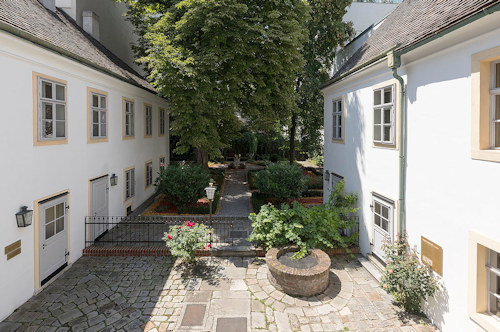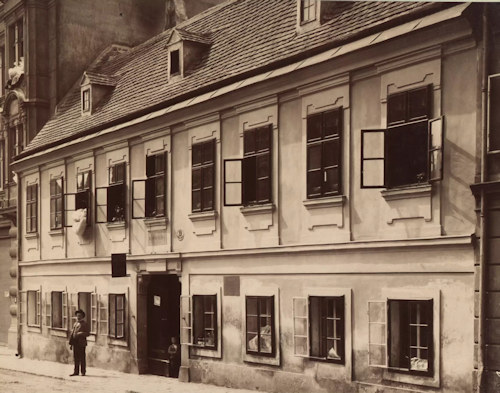
Haydn’s final residence offers another chance to get up close to the life and times of one of history’s greatest composers. The Haydnhaus includes such treats as original instruments owned by the master.
- Haydn lived here for 12 years
- Exhibition covers the period & his works
- One room dedicated to Brahms
- Book a concert experience* for Vienna
- See also:
- Haydn location guide
- One-time free entry with the Vienna All-inclusive Pass
House & museum

(View of the house along the appropriately-named Haydngasse)
So there he sat. Our Mr Haydn. Over 200 years ago. Tinkling away on his keyboard, testing some ideas, and then putting a few notes down on paper.
And there you are. Looking at the exact same instrument. Standing in the exact same room where the mighty composer slept and composed.
In 1793, aged around 61, Haydn bought a house in Gumpendorf. This leafy and quiet village lay outside Vienna but now forms part of the city’s 6th district.
It would be four years until Haydn moved in (among other things, he filled the intervening time with a long trip to London), but the house became his residence until his death there in 1809. And Haydn’s occupancy coincides with perhaps his period of greatest celebrity.
Fortunately for us, the building has survived intact. The Wien Museum restored the house with delicate historical accuracy and turned it into a small, permanent Haydn exhibition.
Inside the Haydn House
Rather incongruously, a virtual parrot greets you when you enter the courtyard through the big wooden doors. Apparently, Haydn bought a parrot when in London.

(The inside courtyard; press photo by Lisa Rastl and © Wien Museum)
Beyond lies a peaceful garden, built in the style of the early 1800s, with a mix of fruit-bearing and ornamental plants.
In summer, you can sit in the shade of the giant chestnut tree and contemplate the opening bars to your next symphony. Or sit and wait for the local bars to open.
The house itself features few fittings and furnishings, since most of the originals were sold off after Haydn’s death. Instead, we have two exhibitions to explore.
The exhibition on the ground floor (where the servants worked), has small sections dedicated to:
- The Vienna and Gumpendorf of the time (early 1800s)
- Haydn’s period of residency
- Haydn’s London trips
- Those selfsame servants
I’ll never tire of seeing pictures of rural idylls like late 18th-century Gumpendorf, and always smile at the contrast to the streets outside in modern Vienna.
The exhibition is not huge but gives you enough flavour to understand the context of Haydn’s later life.
You already begin to see he was no ordinary man. For example, he left his servants more in his will than he gave to all but one of his actual family members.
The exhibition upstairs then allows musical acolytes to feast on the genius of “Papa Haydn”.
When you get to the top of the curving stone steps, start on your left. Hadyn slept in this small room and spent his mornings pottering about on a clavichord. Not just any instrument, but the very one standing innocuously next to you.
The rest of this area includes the reception room, salon and the room where the master displayed the many gifts he received throughout his career. The items are few, but, again, enough to give you a flavour of the man and his work.

(Exhibition view; press photo by Lisa Rastl and © Wien Museum)
Highlights for me:
- Little tidbits on the work that went into The Creation and The Seasons, both composed in this house (including a first edition score of the latter, for example).
Incidentally, I once read a letter sent to the Allgemeine Musikalische Zeitung paper describing the reader’s reaction to the premiere of The Seasons (my translation):
The audience switched between silent reverence, wonder, and pure enthusiasm.
Apparently, every word of the poem behind the libretto was…
…filled with life and emotion in the hands of this musical Prometheus.
- A pianoforte Haydn also used (eek!)
- A list of visitors to this home, including the likes of Beethoven.
- Insight into Haydn’s slow decline with age; how the spirit was still willing and creative but the body and memory weak. Most poignantly, perhaps, his visiting card simply states (alongside some bars of music):
All my strength has gone, old and weak am I

(Photograph of the Haydnhaus from 1900 by August Stauda; Wien Museum Inv.-Nr. 24480; excerpt reproduced with permission under the terms of the CC0 licence)
The displays also provide a little more detail on Haydn’s death during Napoleon’s second invasion of Vienna. If you thought celebrity worship was a modern invention, the information here will put you right. The parrot, for example, sold for a fortune.
Despite the relatively spartan displays, you get an excellent feel for Haydn’s character, his work processes, and the context in which he lived. Strange to say, I came away thinking I’d probably quite like him, not least because of his considerable charity work.
All-in-all, it makes for a thoroughly enjoyable time spent learning about one of the world’s most important composers.
Incidentally, the museum dedicates the last room upstairs to Brahms (whose main Viennese apartment is – alas – no more). You’ll find furniture, a biographical timeline, portraits, etc.
I found the paintings of Brahms’ piano room and desk curiously fascinating, showing a big bust of Beethoven above his piano and what looks like the model of a lobster on his desk. Each to his own, I suppose.
Tickets & visitor tips
Adult entrance tickets cost €5 at the time of writing. The Vienna All-Inclusive Pass (see a review) gets you in once for nothing.
- We took things slowly and finished in under an hour, so it doesn’t require a big time commitment
- An audioguide supports a more detailed visit. We didn’t use it and still got plenty out of the trip
- The house is close to Mariahilfer Straße, which is Vienna’s main shopping street and just a couple of streets down from a traditional coffee house with a local feel: Café Jelinek
- The ticket office has a very small shop, mainly selling a few Haydn books and CDs
How to get to the Haydn House
Although relatively central, the house sits in a little hole as far as public transport is concerned. So you’ll need to walk for a few minutes to get there.
The 57A bus runs along Gumpendorfer Straße below Haydngasse (get out at Brückengasse or Hirschengasse). But your best bet is probably to take the U3 subway to Zieglergasse and walk down (see the map below).
Incidentally, the neighbouring stop (Neubaugasse) on the U3 to Zieglergasse drops you at the 1887 Haydn monument.
The Haydn House is not too far from Westbahnhof, either, one of Vienna’s major rail stations and reached by the U3 and U6 subways, as well as trams 5, 9, 18, 49, 52 and 60. If you come out of the Westbahnhof subway station, look for the “Innere Mariahilfer Straße” exit.
Address: Haydngasse 19, 1060 Vienna | Website